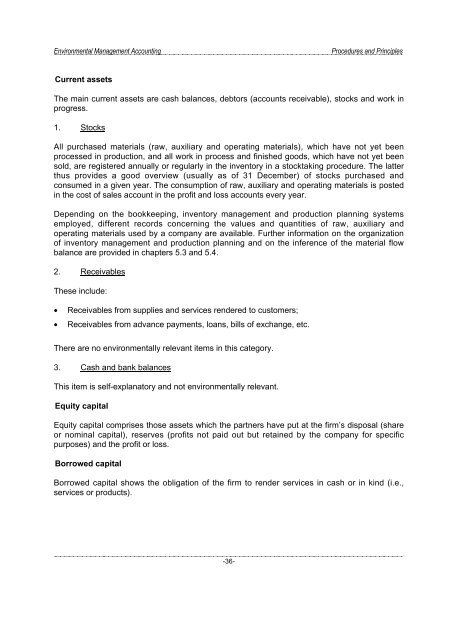Environmental Management Accounting Procedures and Principles
Environmental Management Accounting Procedures and Principles
Environmental Management Accounting Procedures and Principles
Create successful ePaper yourself
Turn your PDF publications into a flip-book with our unique Google optimized e-Paper software.
<strong>Environmental</strong> <strong>Management</strong> <strong>Accounting</strong><br />
<strong>Procedures</strong> <strong>and</strong> <strong>Principles</strong><br />
Current assets<br />
The main current assets are cash balances, debtors (accounts receivable), stocks <strong>and</strong> work in<br />
progress.<br />
1. Stocks<br />
All purchased materials (raw, auxiliary <strong>and</strong> operating materials), which have not yet been<br />
processed in production, <strong>and</strong> all work in process <strong>and</strong> finished goods, which have not yet been<br />
sold, are registered annually or regularly in the inventory in a stocktaking procedure. The latter<br />
thus provides a good overview (usually as of 31 December) of stocks purchased <strong>and</strong><br />
consumed in a given year. The consumption of raw, auxiliary <strong>and</strong> operating materials is posted<br />
in the cost of sales account in the profit <strong>and</strong> loss accounts every year.<br />
Depending on the bookkeeping, inventory management <strong>and</strong> production planning systems<br />
employed, different records concerning the values <strong>and</strong> quantities of raw, auxiliary <strong>and</strong><br />
operating materials used by a company are available. Further information on the organization<br />
of inventory management <strong>and</strong> production planning <strong>and</strong> on the inference of the material flow<br />
balance are provided in chapters 5.3 <strong>and</strong> 5.4.<br />
2. Receivables<br />
These include:<br />
• Receivables from supplies <strong>and</strong> services rendered to customers;<br />
• Receivables from advance payments, loans, bills of exchange, etc.<br />
There are no environmentally relevant items in this category.<br />
3. Cash <strong>and</strong> bank balances<br />
This item is self-explanatory <strong>and</strong> not environmentally relevant.<br />
Equity capital<br />
Equity capital comprises those assets which the partners have put at the firm’s disposal (share<br />
or nominal capital), reserves (profits not paid out but retained by the company for specific<br />
purposes) <strong>and</strong> the profit or loss.<br />
Borrowed capital<br />
Borrowed capital shows the obligation of the firm to render services in cash or in kind (i.e.,<br />
services or products).<br />
-36-




